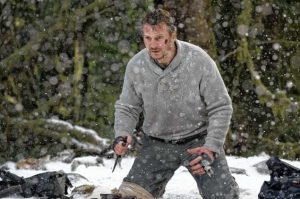 One of the most suprising and effective survival films of in a long time, The Grey is a nerve-wracking drama that wrings quite a lot from very little while submitting viewers to a glimpse of an icy hell on earth. It’s hard to believe it’s from director Joe Carnahan and produced by Tony Scott, whose respective screamingly over-the-top productions tend to be the exact opposite of something so nuanced as this.
One of the most suprising and effective survival films of in a long time, The Grey is a nerve-wracking drama that wrings quite a lot from very little while submitting viewers to a glimpse of an icy hell on earth. It’s hard to believe it’s from director Joe Carnahan and produced by Tony Scott, whose respective screamingly over-the-top productions tend to be the exact opposite of something so nuanced as this.
It starts off quietly, with narration by John Ottway (Liam Neeson) via a letter he’s writing to his wife illustrating the depths of his loneliness and despair. Ottway works for an oil company at a remote Alaskan drilling site, where he’s paid to shoot wolves that get too close to the roughnecks, whom he describes as “ex-cons, drifters, fugitives… men unfit for mankind.” Ottway is the epitome of a man dead on the inside, detached from everyone and everything around him. The reasons that he’s been ground down to the point of suicidal tendencies are gradually revealed.
When the plane carrying Ottway and others home to Anchorage crashes in the wilderness in a white-knuckle sequence that won’t do much for viewers afraid to fly, Ottway and six others are left in the unenviable position of struggling to survive sub-freezing temperatures long enough to find a way back to civilization. If that were not bad enough, they soon discover they are in the middle of the hunting grounds of a pack of immense timber wolves who quickly begin stalking and picking off these unwanted intruders.
Granted it all sounds rote and by-the-book, but Caranahan and screenwriter Ian Mackenzie Jeffers (adapting his short story “The Ghost Walkers”) aim a little higher than just “it’s Taken meets The Edge“. Somewhere around the halfway point the story subtlety switches gears, investing as much into its characters as it does the tense action beats. Caranahan and Jeffers deftly blend a survival thriller with something more existential, as these coarse men begin to face their mortality and the very real and quite likely fact that they’re going to die.
As with the rest of Carnahan’s filmography, testosterone runs rampant, with the men battling for alpha male status just as much as their canine counterparts; unlike most of the rest of his work, it serves a purpose here. It’s tempting to say that it’s reminiscent of Ernest Hemingway’s or Jack London’s tales of hard, introspective men whose struggles with a forbidding environment mirror their inner battles. Carnahan and Jeffers invest enough development into their characters to give them depth while avoiding the cliches and easy outs that viewers often expect. There’s an amount of subtlety in The Grey that hasn’t been seen in Carnahan’s work since Narc (2002).
The precision pacing never falls apart — its 117 minutes fly by — and it never ceases to be gripping. Cinematographer Masanobu Takayanagi’s grainy photography compliment’s the story with a color palette that jarringly shifts from the warm yellow-orange glow of Ottway’s dreams about his wife to the dreay white snow- and grey mist-shrouded landscape that wants to claim him.
Neeson is at his best here as the resourceful, determined, and somewhat paternal hero, and he’s backed by a strong supporting cast that includes Dermot Mulroney, Dallas Roberts, Frank Grillo, and James Badge Dale. The emotions that drive Ottway are palpable, and the hints at lost love can’t help but bring to mind Neeson’s loss of his wife Natasha Richardson three years ago. If the material is Neeson’s way of coping, then the wolves don’t stand a chance.
“Man on a Ledge”:
 Execution is key when it comes to a good — or even just a passable — thriller, especially one that hinges on an implausible gimmick or plot concept. If you try to fake you’re way through it, it’ll collapse faster than a house of cards in an earthquake. Director Asger Leth’s and screenwriter Pablo Fenjves’ high-concept, low-yield drama Man on a Ledge flirts with B-movie greatness but comes up short thanks to the far-fetched plot device used to power a clunky hybrid of heist flick/Hitchockian wrong-man thriller.
Execution is key when it comes to a good — or even just a passable — thriller, especially one that hinges on an implausible gimmick or plot concept. If you try to fake you’re way through it, it’ll collapse faster than a house of cards in an earthquake. Director Asger Leth’s and screenwriter Pablo Fenjves’ high-concept, low-yield drama Man on a Ledge flirts with B-movie greatness but comes up short thanks to the far-fetched plot device used to power a clunky hybrid of heist flick/Hitchockian wrong-man thriller.
The set up is a ripe one: in the opening minutes of the movie, Nick Cassidy (Sam Worthington) checks into a midtown Manhattan hotel, orders lunch from room service, and at the conclusion of his meal climbs out the window and onto the ledge some 25 stories up.
In flashback we learn that Nick was an NYPD detective who may or may not have killed another cop and stolen an exceptionally valuable fist-sized diamond belonging to uber-rich developer David Englander (Ed Harris). Days before his arrival at the hotel, Nick was escaped from prison. His pseudo-suicidal antics are supposed to be a subtle act of manipulation to draw out oppposing parties, spur investigation into his case, and serve as a distraction while his younger brother Joey (Jamie Bell) and Joey’s fiancee Angie (Genesis Rodriguez) break into a vault to obtain some exculpatory evidence, using more ridiculously elaborate break-in techniques than the average Mission: Impossible installment.
Nobody else knows this at first — not the detective (Edward Burns, proving that he is indeed still alive and making movies) who initially responds to the case, the SWAT Captain (Titus Welliver) who’s itching to get Nick down by any means necessary, or the police negotiator (Elizabeth Banks) whom Nick personally requests.
Over-the-top flicks like these can — and often do — work if they’re able to sell their gimmicks to the audience. Phone Booth and Nick of Time are prime examples, both of which generated anough energy and suspense to suck the viewer into the goofy plot and make them want to stick with just to see how the nonsense panned out, and did so in roughly 90 minutes.
Man on a Ledge fails on all of those fronts. It takes forever to set up a ridulous situation that never rises to the level of mad genius required to make it work. A fugitive decides to exonerate himself by staging a public suicide attempt that is really a diversion designed to draw out guilty parties while the B-team steals the evidence from a nigh-impregnable vault? Not even The Negotiator was this absurd.
Worthington broadens his range a bit, but seems either unwilling or unable to fully invest Nick with the vulnerability the character demands, or even a passable New Yawk accent. The actor has been a promising talent since he arrived on the global scene with Terminator: Salvation in 2009, but so far hasn’t lived up to that promise. (And no, despite it’s massive box office success, Avatar doesn’t count; in that orgy of eye candy, he and everbody else — with the possible exceptions of Sigourney Weaver and Stephen Lang — were shoved into the background by the special effects.)
The characters are mostly stock types saddled with bad dialogue, and we see their backstories and betrayals coming from a mile away. If any of them escape relatively unscathed, it’s Banks as Detective Lydia Mercer. She’s ridiculed for being a female in the NYPD boy’s club, which makes her genuinely sympathetic, and her vocal disdain for the most of other characters makes her very relatable. Why couldn’t the movie have been about her?
Fenjves makes a half-hearted attempt at social satire, as if he felt obligated to legitimize his slab of B-grade cheese: Kyra Sedgwick hams it up as the obligatory predatory TV news reporter Suzy Morales (over-rolling the “R” in her name in a gag that was play out a good 20 years ago) and her man-on-the street interviews parsed throughout the movie touch on everything from police corruption to the 99 percent; at one point, chants of “ATTICA! ATTICA!” are even brought out and dusted off. And that’s just the dialogue that doesn’t (ahem) fall flat.





